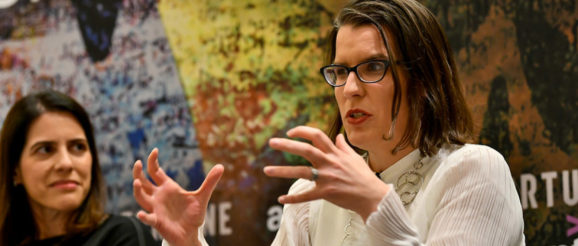The ‘Blameless Post Mortem’ and Other Techniques That Spur Innovation

At personal styling service Stitch Fix, employees gather for a “blameless post mortem” whenever there’s a big problem.
“You bring everyone into the room and the rules are there are no rules—no pointing fingers,” Stitch Fix chief technology officer Cathy Polinsky said at Fortune’s Most Powerful Women Next Gen summit in Laguna Niguel, Calif. on Tuesday. “It’s okay to make a mistake, but lets all learn together.”
Failures, distractions, mistakes, lessons—whatever you want to call them, companies face a myriad of possible problems while innovating and planning for the future. Staying ahead in a shifting tech landscape means being in the right mindset from the beginning, knowing you won’t be stagnant in a job, but instead always pushing forward with new ideas.
“It’s not right for everyone,” Sigal Cordeiro, vice president of mobility and Maven car rental service at General Motors, noted. “For a lot of people it’s extremely uncomfortable. Hiring the right people and explaining from the beginning is key.”
Once the right people are hired, the most important way to keep innovation flowing are to be hyper focused. “It can be very distracting if you don’t have a clear vision of what you want to do, where you want to go,” Cordeiro added. “And resources are limited.”
Polinsky said she saw this at both Salesforce, where she previously worked, and Stitch Fix — a need to juggle putting enough resources into innovation while not losing focus. For Stitch Fix that meant deciding against launching sales in multiple verticals of clothing all at once. The company started with just clothing for women then later rolled out menswear, childrens’, and international.
Julie Larson-Green, chief experience officer of experience management company Qualtrics, said there’s one part of the journey that many people forget. They focus on the outcome, but they forget to think ahead of time about things like what are the opportunities and what are the risks. She says you need to get colleagues to agree on that at the beginning of a new project.
“Innovation is idea plus impact. Everything you do you have to put through a scientific method of hypothesis, solution, measurement, then circle back around,” Larson-Green said.
Another key is frequently communicating with everyone involved, says Cordeiro. “There is no over-communicating. The message needs to be reinforced every time you have an opportunity.”
She said she’s a fan of having people dedicated to innovation, and out of that will come renovation.
Larson-Green notes that all innovative concepts aren’t about being brand new. They can be about retooling to fit consumer needs better over time. What has changed since the inception? Focus on that and work towards a solution.
For example, Larson-Green mentioned Windows from when she worked at Microsoft. When the software was first created things were wildly different. Fast forward ahead a couple of decades and people use it on their smartphones, something she needed to take into account for newer versions.
“Rethink what got you there,” she says.
—Leadership lessons from a Deloitte partner who races cars in her spare time
—Debunking the myth of workplace ‘Mean Girls’
—J.C. Penney’s retail lab is at the center of CEO Jill Soltau’s turnaround plans
—Can virtual reality teach executives what it feels like to be excluded?
—Ellen Kullman becomes an exception: a woman who’s been CEO—twice
Keep up with the world’s most powerful women with The Broadsheet newsletter.
